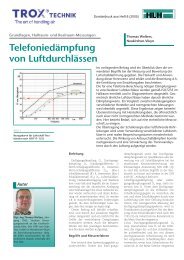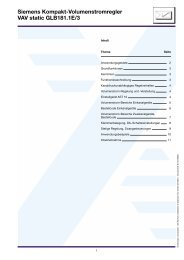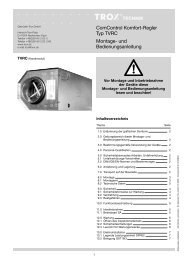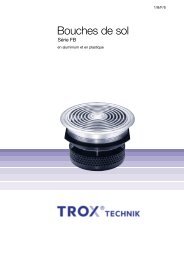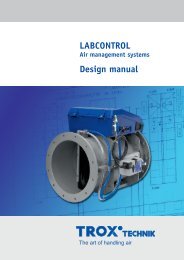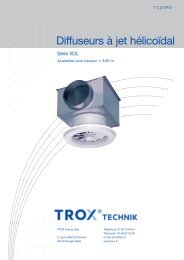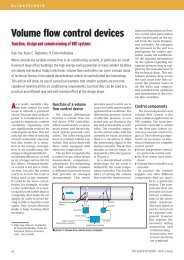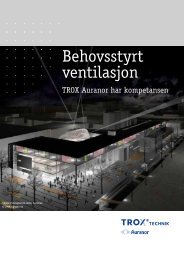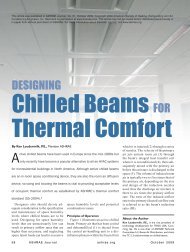Standard-PDF - TROX
Standard-PDF - TROX
Standard-PDF - TROX
You also want an ePaper? Increase the reach of your titles
YUMPU automatically turns print PDFs into web optimized ePapers that Google loves.
<strong>TROX</strong> GmbH<br />
Heinrich-Trox-Platz<br />
47504 Neukirchen-Vluyn, Germany<br />
Tel.: +49 (0)2845/20 2-0<br />
Fax: +49 (0)2845/20 2-265<br />
trox@trox.de<br />
www.trox.de<br />
life<br />
magazine jun/2 012<br />
Stadium air.<br />
Stadiums and their particular flair.
American Football<br />
Bogenschießen<br />
Fußball nach australischen Regeln<br />
Baseball<br />
Basketball<br />
Cricket<br />
Fußball<br />
Gälischer Fußball<br />
Galopprennen<br />
Eishockey<br />
Kickboxen<br />
Skifahren<br />
Tischtennis<br />
Rugby<br />
Wrestling<br />
Keine Information<br />
<strong>TROX</strong> life magazin – streiflichter 17<br />
contents<br />
project report<br />
EURO 2012 - Kick-off in Warsaw.<br />
Page 004<br />
feature<br />
Turf ventilation.<br />
Page 010<br />
feature<br />
Fire protection in stadiums.<br />
Page 014<br />
highlights<br />
Panem et circenses.<br />
Page 016<br />
highlights<br />
Modern arenas.<br />
Page 018<br />
forum & economy<br />
Sport as an economic factor.<br />
Page 020<br />
science & technology<br />
About a ball.<br />
Page 022<br />
lifestyle<br />
Open air.<br />
Page 028<br />
reportage<br />
Highly efficient stadiums.<br />
Page 032<br />
interview<br />
The 2014 World Cup.<br />
Page 036<br />
trox internal<br />
The Heinz Trox Foundation: 20 years on.<br />
Page 040<br />
trox news<br />
X-CUBE on air.<br />
Page 041<br />
apostil<br />
Cup final.<br />
Page 042<br />
life<br />
magazine jun/2 012<br />
Stadium air.<br />
Stadiums and their particular flair.<br />
viewpoint<br />
A fresh breath of stadium air.<br />
At last, football reigns supreme again! Starting on 8 June, Poland and Ukraine<br />
will host the 2012 European Championship. When all our national football teams<br />
compete for the title, the championship venues will glow with football fever.<br />
To ensure that the stadium climate is not brought to a boil in the heat of the<br />
action, <strong>TROX</strong> has supplied air conditioning components for the arenas. They make<br />
for a healthy, comfortable climate and improved safety.<br />
<strong>TROX</strong> technology is at play in seven out of eight official European Championship<br />
stadiums, which is the perfect excuse for offering our readers a tour of the world of<br />
stadiums and arenas. However, our latest magazine not only contains exciting facts<br />
and anecdotes to do with football; <strong>TROX</strong> life also has a look behind the scenes of football<br />
and stadium management.<br />
The next World Cup is already shaping events. It will take place in 2014, in the most<br />
football-crazy country on earth: Brazil. Our colleagues of <strong>TROX</strong> Latin America are in<br />
the midst of planning for the largest stadiums in Brazil; the refurbished football temple<br />
Maracanã in Rio de Janeiro, among others. Of course, the air handling units will face<br />
particularly great challenges in Brazil’s hot climate.<br />
Find out more about the progress on the famous World Cup arena in Rio and the<br />
issues that planners and architects have to deal with in this legendary football venue<br />
in our interview with Brazilian star architect Daniel Fernandes. Brazil expects the<br />
matches to be boisterous and cheerful and <strong>TROX</strong> is taking part in the best way we know<br />
how: by providing ventilation components for the country’s most important stadiums.<br />
We are all looking forward to an exciting European Championship and wish you an<br />
interesting read of our magazine entitled “Stadium air”.<br />
Lutz Reuter<br />
Chairman of the Board of Management of <strong>TROX</strong> GmbH<br />
<strong>TROX</strong> life magazine – viewpoint 3
project report<br />
EURO 2012<br />
Kick-off<br />
in Warsaw.<br />
An opening match<br />
on historic ground.<br />
4 <strong>TROX</strong> life magazine – project report<br />
When the referee blows the starting whistle<br />
at the European Championship opening match<br />
between Poland and Greece on 8 June, <strong>TROX</strong><br />
technology in Poland’s National Stadium will<br />
make sure that there is no reason for the<br />
55,000 spectators to panic even in the event<br />
of a fire.<br />
<strong>TROX</strong> life magazine – project report 5
Poland<br />
project report<br />
Warsaw’s new landmark.<br />
On the shore of the Vistula River, a multifunctional<br />
arena for 55,000 spectators has been built. It is the only<br />
one among the eight European Championship stadiums<br />
with a retractable roof. The new building sits on an<br />
embankment that was erected in 1955 with rubble from<br />
the Warsaw Uprising and has since been the site of the<br />
Dziesi ˛ eciolecia National Stadium. To the city, it was very<br />
important that the existing embankment be disturbed<br />
as little as possible. The two lower levels of the<br />
new construction were therefore embedded in the<br />
embankment topography. Neither the level of the<br />
embankment crest nor that of the existing playing field<br />
was altered. The access roads, the geometry of the<br />
embankment and the two tunnels leading into the<br />
stadium were kept and integrated in the new building.<br />
The revival of this historic site as a sports centre with<br />
the “new” national stadium represents a cornerstone in<br />
Poland’s national identity.<br />
Fire protection and smoke extract technology from <strong>TROX</strong><br />
prevents fire and smoke from spreading uncontrollably.<br />
Besides superior fire protection technology, <strong>TROX</strong> sound<br />
attenuators and air terminal units have also been<br />
installed in Poland’s National Stadium. Moreover, an<br />
intelligent BMS ensures that the security and reliability of<br />
the technical building services can be monitored at any<br />
time. Warsaw is one of seven European Championship<br />
stadiums where <strong>TROX</strong> technology is in use.<br />
The new EC stadiums at a glance:<br />
Warsaw<br />
National Stadium Warsaw<br />
Capacity: 58,145<br />
6 <strong>TROX</strong> life magazine – project report<br />
Poznan<br />
Municipal Stadium Poznan<br />
Capacity: 43,090<br />
A European Championship<br />
of great distances:<br />
1,835 km from Gdansk<br />
to Donetsk.<br />
Poznan<br />
Gdansk<br />
Wroclaw<br />
© Wroclaw 2012 Sp. z o.o.<br />
Wroclaw<br />
Municipal Stadium<br />
Wroclaw<br />
Capacity: 42,771<br />
Warsaw<br />
Gdansk<br />
PGE ARENA Gdansk<br />
Capacity: 41,582<br />
National Stadium Warsaw // Copyright: ALPINE, PGE ARENA Gdansk // Copyright: ALPINE, Municipal Stadium Posen // Copyright: Euro Poznan 2012<br />
Lviv<br />
Kiev<br />
Ukraine<br />
© Ukrinform<br />
Kharkiv<br />
Donetsk<br />
Kiev<br />
National Sports Complex<br />
(NSC) « Olimpiyskiy»<br />
Capacity: 70,050<br />
Lviv<br />
Arena-Lviv<br />
Capacity: 34,915<br />
Kharkiv<br />
Metalist Stadium<br />
Capacity: 38,633<br />
Facts on the project<br />
Building owner: Narodowe Centrum Sportu<br />
Sp. z o.o.<br />
Construction time: 2008–2011<br />
Architects: gmp – Architects of Gerkan, Marg<br />
and Partner (draft) together with J.S.K.<br />
Architekci, Warsaw, and Schlaich Bergermann<br />
and Partner, Stuttgart, Germany<br />
BSE implementation: Imtech Polska<br />
Seats: 55,000<br />
VIP lounges: 68, VVIP lounges: 1<br />
Corporate seats: 2,600<br />
Press seats: 580<br />
Underground parking spaces: 1,800<br />
Length of stadium: 314 m<br />
Width of stadium: 280 m<br />
Height of stadium: 97 m<br />
Information on BSE<br />
76 air handling units<br />
1.5 million m 3 /h air volume<br />
2,700 fire dampers<br />
3,000 radiators<br />
Approx. 1,000 toilet units<br />
More than 35,000 sprinkler heads<br />
Heating capacity 15 MW<br />
Electric power rating 4 x 2,000 kVA<br />
Total air volume 1,500,000 m 3 /h<br />
Smoke extract air volume 1,200,000 m 3 /h<br />
Large metal baffles in the national colours red and white and interwoven façade elements create an<br />
intriguing interplay of light and shadows.<br />
Donetsk<br />
Donbass Arena<br />
Capacity: 51,504<br />
<strong>TROX</strong> life magazine – project report 7<br />
© ALPINE
project report<br />
Air handling units handle 1 million<br />
cubic metres of air per hour.<br />
Masterful achievement, technically and architecturally.<br />
Nestled in its surroundings, the arena will become a<br />
landmark visible for miles around. The commercial area<br />
includes various shops, offices, restaurants and pubs,<br />
cinemas, a gym, a museum and fan club facilities. The<br />
Diffusers, such as jet nozzles in<br />
the upper stands, are also used for<br />
“airing” the turf.<br />
Innovative air control blades offer<br />
extremely quiet air control and optimum<br />
swirl generation, the ideal comfortable<br />
climate in lounges, restaurants, press<br />
centres and changing rooms.<br />
underground car park is one of the largest in Poland with<br />
1,800 spaces. The requirements for fire and smoke<br />
protection for this huge construction were no less<br />
daunting. Building services engineers and fitters worked<br />
under immense time pressure. Andrzej Marciniewicz,<br />
project manager for the National Stadium, and his team<br />
Superior fire and smoke protection<br />
technology ensure first-class safety<br />
for spectators.<br />
3D Model of a stadium equipped with air handling units.<br />
worked around the clock to finish on time: “The tight<br />
schedule meant that we had to organise ourselves in two<br />
or even three shifts. However, we are proud, and rightly<br />
so, that we were able to install the central heating<br />
system with an output of 15 MW and the heat supply for<br />
the entire complex in only two months. Every day, an<br />
Volume flow controllers not only<br />
ensure that the ventilation is adapted<br />
to the current demand but also<br />
increase energy efficiency, especially<br />
as a stadium is only in use at weekly<br />
intervals.<br />
Splitter sound attenuators not only<br />
absorb the noise of the air handling<br />
units; a special design means that they<br />
can also be used for noise insulation,<br />
keeping the cheers from the fans within<br />
the stadium.<br />
average of 350 to 400 fitters worked on the site – at<br />
peak times, even up to 800 people!”<br />
8 <strong>TROX</strong> life magazine – project report <strong>TROX</strong> life magazine – project report 9<br />
© NCS
feature<br />
Turf<br />
ventilation.<br />
Aerodynamic tests<br />
ensure the grass<br />
is greener on the<br />
inside.<br />
When aerodynamics engineers hear the grass grow, they<br />
are without doubt considering the aerodynamic design of<br />
modern football stadiums.<br />
10 <strong>TROX</strong> life magazine magazin – – standpunkt feature<br />
<strong>TROX</strong> <strong>TROX</strong> life life magazin magazine – standpunkt – feature 11
feature<br />
According to FIFA,<br />
there are approx. 25,000 leaf blades<br />
per m 2 , i.e. 200 million blades, on<br />
a playing field.<br />
The turf is normally replaced once or<br />
twice per year.<br />
12 <strong>TROX</strong> life magazine – feature<br />
INNIUS GTD GmbH in Dresden, Germany, a well-established specialist on complex computer-assisted<br />
calculation methods, has carried out advanced simulations for the Allianz Arena to provide the best<br />
possible conditions for the turf, well ahead of the construction.<br />
Grass needs to breathe, too!<br />
Not since the erection of the Veltins Arena in<br />
Gelsenkirchen, Germany, where the grass is taken out of<br />
the stadium for ventilation and to soak up sunlight,<br />
we know that preserving the green inside the modern<br />
football temples, where the stands are built very close to<br />
the playing field, has become a real problem for the turf<br />
managers. The small openings in the roof or even closed<br />
retractable roofs mean that the turf does not get enough<br />
natural light or enough air. As a result, many stadiums<br />
have to replace the turf several times a year, even up to<br />
six times (Amsterdam Arena), depending on their use.<br />
In Munich’s Allianz Arena, the grass is normally only<br />
replaced twice a year. Thanks to the translucent roof<br />
(light permeability 400 and 660 nm, 98 per cent UV<br />
permeability), the grass is guaranteed a vigorous growth.<br />
Turf ventilation is also ensured as the wind may flow from<br />
every direction under the stadium structure across the<br />
playing field. Both the profile of the exterior façade and<br />
the lower outline of the second tier produce a “nozzle effect”,<br />
which helps provide good ventilation. The first tier<br />
was made lower than the others to allow for laminar air<br />
flows. In other stadiums, ventilators are used to imitate<br />
wind movement and the pitch even has artificial light.<br />
As you can see, the aerodynamic design of a stadium<br />
is no longer all about spectator comfort. Sophisticated<br />
CFD* simulations are used particularly to ensure<br />
optimum air supply to the grass in the stadium.<br />
The innovative simulation technology employed for the<br />
Allianz Arena calculated the use of energy in the entire<br />
stadium structure, based on a specified user profile and<br />
a reference year of Munich climate data in hourly<br />
intervals. The aim was to analyse the possibilities and<br />
limitations of sufficient natural ventilation and air<br />
conditioning of the stadium interior under different<br />
weather conditions and building loads. The analysis<br />
showed that better turf aeration meant poorer<br />
spectator comfort and vice versa. The balance between<br />
a healthy turf and a happy audience was skilfully struck<br />
by architects and planners, to make for optimum<br />
climatic and aerodynamic conditions in the arena.<br />
*CFD – Computational Fluid Dynamics<br />
The ideal green.<br />
Turfed area 8000 m2 (111 x 71 m gross, 105 x 68 m net),<br />
approx. 400 rolls<br />
Cost of<br />
laying rolled turf 100,000 euros or more<br />
Sowing time Ideally 14 months<br />
Grass mix 25% tall-growing ryegrass<br />
and 75% horizontally spreading<br />
Kentucky bluegrass.<br />
Hybrid turfs Synthetic fibres are implanted in the existing<br />
natural turf. The roots of the natural grass<br />
establish themselves around the synthetic<br />
fibres and fix the sod of the rolled turf into a<br />
stable, even playing field.<br />
Stripe pattern The mowed grass is rolled into the mowing<br />
direction. The pattern created by changing<br />
mowing direction reflects the light differently,<br />
producing the effect of darker and brighter<br />
stripes.<br />
Mowing height On the day of the match 25–28 mm<br />
Photosynthesis The leaf blades require light of wavelengths<br />
435 nm and 660 nm. A complete<br />
photosynthesis takes place at 10,000 lux.<br />
Illuminance Daylight of around 13,000 lux<br />
© ANSYS<br />
<strong>TROX</strong> life magazine – feature 13
feature<br />
Fire protection<br />
in stadiums.<br />
If flares are lit, the smoke must be<br />
extracted from the stadium as<br />
quickly as possible.<br />
Besides spectator and player comfort, as well as optimum turf conditions, safety is<br />
one of the main issues when building a stadium. 95 % of fire-related deaths are<br />
actually caused by the smoke. That is why keeping the stadium smoke-free, or at<br />
least limiting the amount of smoke in the spectator areas in the event of a fire, is<br />
so important.<br />
Calculations based on simulations assume that the stands need to be kept smoke-free<br />
for 20 to 30 minutes in order for the audience to be able to leave the stadium<br />
unharmed. Jet nozzles are therefore used to improve the extract of smoke. Due to their<br />
inductive effect, they absorb the smoke and transport it toward the outlet in the stadium<br />
roof. This ensures that even the people in the top stands have time to escape the<br />
stadium unharmed.<br />
When flares are lit.<br />
Despite rigid security checks, fans often manage to smuggle pyrotechnics past<br />
security staff. People in the audience, particularly among the fanatics, often light flares.<br />
In view of the complex air flows and shifting ambient conditions, it is hardly possible to<br />
predict smoke propagation using conventional methods. Planning engineers are<br />
therefore aided by intelligent software, which accurately predicts the forming and<br />
circulation of smoke based on specific planning parameters and ambient conditions.<br />
This makes for very safe football stadiums around the world.<br />
CFD analysis by INNIUS GTD GmbH for the Allianz Arena<br />
in Munich: simulating the propagation and concentration<br />
of smoke when a smoke bomb explodes.<br />
14 <strong>TROX</strong> life magazine magazin – – standpunkt feature<br />
<strong>TROX</strong> life magazine – feature 15<br />
© ANSYS
highlights<br />
Panem et<br />
circenses.<br />
Antique arenas.<br />
16 <strong>TROX</strong> life magazine – highlights<br />
Even the ancient Romans knew of the “power of<br />
the games”. Satirist Juvenal coined the expression<br />
“panem et circences”, saying that the Roman<br />
people who, at the time of the functioning<br />
republic granted generals their mandates and<br />
elected their public officers, had become sheepish<br />
and depoliticised, only wanting two things: bread<br />
and entertainment.<br />
To this date, it refers to raising the spirits of the<br />
public (electorate) with generous election-time<br />
handouts and distracting them from everyday<br />
problems with brash entertainment.<br />
The great arenas of antiquity.<br />
Construction work began under Emperor<br />
Vespasian around AD 70 and was completed<br />
ten years later by Domitian. Nearly<br />
50 metres tall and 188 metres long, the<br />
Colosseum could accommodate 50,000<br />
spectators, according to modern<br />
estimations. As Vespasian ran out of money<br />
during the construction, he imposed a tax<br />
on public lavatories. The saying “money<br />
does not stink” (pecunia non olet) dates from<br />
this era.<br />
After the Colosseum in Rome and Capua’s<br />
arena, Verona boasts the third largest<br />
preserved antique amphitheatre. Other wellpreserved<br />
amphitheatres from the Roman<br />
Empire can be found in Pula on the Istria<br />
Peninsula, and in Nîmes and Arles in France.<br />
They could each hold around 25,000 visitors.<br />
<strong>TROX</strong> life life magazin magazine – streiflichter – highlights 17
highlights<br />
Modern<br />
arenas.<br />
Some<br />
stadium trivia.<br />
The largest number of spectators...<br />
...can be seated by Strahov Stadium in Prague. During the<br />
Communist era, up to 220,000 people gathered here regularly.<br />
With its 8 playing fields, surrounded on all sides by stands, the arena<br />
was used mainly for massive synchronized gymnastics displays<br />
(Spartakiads).<br />
The May First Stadium in Pyongyang (150,000 seats) and the<br />
Salt Lake Stadium in Kolkata (120,000 seats) are thought to be<br />
the largest two “classical” stadiums in the world to host football<br />
matches. Among the arenas used purely for football, the Azteca<br />
Stadium in Mexico City with 105,064 seats is the world‘s largest.<br />
Maracanã, generally considered to be the largest stadium, owes its<br />
reputation to former times, when there were no safety restrictions.<br />
Rio‘s legendary arena is therefore thought to have accommodated up<br />
to 200,000 football fans. Today, the official seating capacity is a<br />
mere 96,000.<br />
<strong>TROX</strong> – a Champions League player<br />
The European Championship stadiums are not the only<br />
venues where <strong>TROX</strong> perfects the art of handling air – the<br />
company has also had a hand in the most spectacular and<br />
famous arenas all over the world: from the Veltins Arena in<br />
Gelsenkirchen, Germany, and the National Stadium in Beijing<br />
to Soccer City in Johannesburg, South Africa, where the<br />
2010 World Cup final was played. In each location, <strong>TROX</strong><br />
has proven a consummate team player when it comes to<br />
© Liu Feng<br />
© Marc Jarmain<br />
ventilation and air conditioning technology. National Stadium, Beijing VELTINS-Arena, Gelsenkirchen, Germany Green Point Stadium, Cape Town Wembley Stadium, London Dubai Sports Swimming Complex<br />
18 <strong>TROX</strong> life magazine – highlights<br />
American Football<br />
Archery<br />
Australian Rules Football<br />
Baseball<br />
Basketball<br />
Cricket<br />
Football (Soccer)<br />
Gaelic Football<br />
Horse Racing<br />
Ice Hockey<br />
Kickboxing<br />
Skiing<br />
Table Tennis<br />
Rugby<br />
Wrestling<br />
No information<br />
A map of the most popular sports.<br />
Football reigns supreme. Without a doubt, it has the greatest number<br />
of supporters worldwide, but many countries hold other sports closer to<br />
heart. In Pakistan, for instance, hockey is the national sport, brought to<br />
the Commonwealth nations by the British, just as cricket. Down Under,<br />
rugby is much more popular than football, whereas American football<br />
and ice hockey gathers the biggest crowds in the US and Canada.<br />
<strong>TROX</strong> life magazine – highlights 19
20 <strong>TROX</strong> life magazine magazin – – wirtschaft forum & economy<br />
und forum<br />
forum & economy<br />
Sport as an<br />
economic factor<br />
Higher, faster, further!<br />
Dr. Erich Gluch, ifo-Institut<br />
“No sports” was allegedly Sir Winston Churchill’s succinct answer to the question of<br />
how he had managed to attain such a respectable age in such good physical shape. It<br />
is a credo hardly embraced by the construction industry. Rather, sport has become an<br />
important growth engine, particularly in so-called emerging markets*. These markets<br />
encompass almost half of the world’s population and generate about a quarter of<br />
the global gross domestic product. No wonder then, that this is where recent great<br />
sporting events have taken place and where upcoming championships will take place.<br />
In Germany, the federal government and the federal states spent 623 million euros<br />
on construction in the sport sector in 2005; in 1995 the figure was 950 million euros.<br />
However, the municipalities are the ones that provide the lion’s share of investment in<br />
construction for sport. Difu, the German institute for urban studies, estimated that the<br />
municipalities would need to raise about 24 billion euros for replacement construction<br />
and another 12 billion euros for catch-up measures in the period from 2005 to 2020.<br />
However, due to the bleak economic outlook, investments are likely to fall short.<br />
Fortunately for the construction sector, privately funded sports facilities are much<br />
more prominent, and not just in Germany. Billions are spent every year on sports<br />
establishments, e.g. football arenas, gyms, rehabilitation centres, fitness centres or<br />
spas. However, the largest sums are invested in construction for top events, as can be<br />
seen in the following figures: Total economic spending for the 2006 World Cup is<br />
estimated to around 10 billion euros, although Germany already had excellent<br />
infrastructure and football stadiums. For the 2010 World Cup in South Africa, the total<br />
investment for infrastructure and stadiums is thought to have been as much as<br />
13 billion euros. The plans for the London 2012 Summer Olympics began rather<br />
“modestly”. The costs have, however, more than tripled. The current estimate is<br />
around 12 billion euros. Still, it ranks as “cheap” in comparison to the announced<br />
24 billion to be spent on the 2014 Winter Olympics in Sochi, Russia. Further<br />
investments worth billions have already been committed for the FIFA World Cups<br />
in Brazil (2014), Russia (2018) and Qatar (2022), and the Olympics hosted by<br />
Rio de Janeiro (2016) and Pyongyang, North Korea (2018).<br />
* emerging markets such as the BRICS states, Brazil, Russia, India, China, South Africa.<br />
<strong>TROX</strong> life magazine – forum & economy 21
science & technology<br />
22 <strong>TROX</strong> life magazine – science & technology<br />
About a ball.<br />
The inflatable natural<br />
product that became<br />
a high-tech gadget.<br />
“You have to caress the ball with your feet to make<br />
it land in the other team’s goal.”<br />
Edson Arantes do Nascimento,<br />
better known as Pelé, thrice World Champion playing for Brazil<br />
<strong>TROX</strong> life magazine – science & technology 23
© adidas (large image, image on right)<br />
science & technology<br />
The transformation of the football<br />
through the ages.<br />
The football has always played<br />
a special role. Players and fans<br />
alike maintain a particularly close<br />
relationship with it. Some say<br />
Uruguay only won the World Cup in<br />
1930 because they played the<br />
second half with “their” ball. In<br />
1966, the leather ball’s antics<br />
24 <strong>TROX</strong> life magazine – science & technology<br />
reached an all-time high in what in<br />
Germany is known as the Wembley<br />
Goal. In or out? After the final<br />
whistle blow, Helmut Haller<br />
smuggled the legendary Wembley<br />
ball out of the stadium underneath<br />
his shirt. Following a campaign in<br />
the British newspapers, he finally<br />
returned it in time for the European<br />
Cup in England in 1996 – in return<br />
for then 180,000 deutschmarks.<br />
Since the 1970 World Cup in<br />
Mexico, there has always been an<br />
official World Cup ball, originally<br />
developed by Adidas. The first<br />
official ball was also the first<br />
to be printed – in classic black<br />
and white, to the great joy of<br />
spectators, who were able to see<br />
the ball much better, whether<br />
watching a match in the stadium or<br />
at home on TV.<br />
The ball becomes even rounder.<br />
In the 1903 FA Cup final, players<br />
were still kicking an inflated pig‘s<br />
bladder about. Covered with leather,<br />
its oval shape made it look more like<br />
a rugby ball. It was not until a rubber<br />
solvent was discovered that balls<br />
could be made using waterproof<br />
rubber tubes, still, they were not<br />
entirely spherical. The lack of a valve<br />
meant that they had to be laced<br />
together. This produced a small<br />
bump which could cause nasty<br />
injuries after headers. In the 1920s,<br />
the non-laced leather ball was<br />
therefore greeted with much<br />
enthusiasm. The hand-crafted,<br />
unreliable round leather, which<br />
absorbed water when it rained and<br />
caused headaches due to the<br />
increased weight, was used until the<br />
1982 World Cup in Spain, although<br />
by then it was partly synthetic. For<br />
the 1978 World Cup in Argentina,<br />
expected to be very rainy, the<br />
leather ball was finally coated with<br />
polyurethane. It was not until after<br />
1982 that the ball was made<br />
completely synthetic. The ball had<br />
become a high-tech gadget.<br />
This year‘s European Cup ball,<br />
called Tango12, is supposed to be<br />
the roundest ball of all times,<br />
according to its designers. The<br />
rounder the ball, the more accurate<br />
the passes, which is why hundreds<br />
of models were developed and<br />
tested in the wind tunnel. In addition,<br />
computer simulations were used to<br />
minimise the number of panels on<br />
the ball. The fewer parts a ball has,<br />
the rounder it is.<br />
Roundness<br />
Water<br />
absorption<br />
Rebound<br />
<strong>TROX</strong> life magazine – science & technology 25<br />
FIFA ball test<br />
criteria:<br />
Circumference
science & technology<br />
The Magnus effect*<br />
The Magnus effect is a phenomenon<br />
of fluid mechanics, which describes<br />
the effect of a perpendicular force to<br />
which a spinning spherical object is<br />
subjected in a fluid. The spinning<br />
object is subject to a force<br />
perpendicular to the line of motion and<br />
the axis of rotation. The spinning<br />
motion causes the particles on the<br />
upper side of the ball to accelerate<br />
and those on the lower side to<br />
decelerate. The velocity distribution<br />
around the ball is therefore<br />
heterogeneous and, according<br />
to Bernoulli’s principle, so is the<br />
distribution of pressure.<br />
*Heinrich Gustav Magnus 1802–1870<br />
Image: Georg-August-Universität, Göttingen,<br />
Germany<br />
Why do golf balls have dimples?<br />
The aerodynamics of the leather<br />
ball.<br />
From an aerodynamic perspective,<br />
a sphere with a smooth surface is<br />
problematic. Any football fan will be<br />
familiar with goalkeeper complaints of<br />
the “knuckleball” phenomenon, which<br />
prevents them from catching the ball.<br />
Scientists at Loughborough University<br />
got to the bottom of the problem.<br />
According to their findings, balls<br />
kicked with little or no spin will move<br />
erratically. However, few players have<br />
mastered this particular way of<br />
Let us take a moment to look at a much smaller spherical<br />
object: the golf ball. Its flight characteristics were improved<br />
almost intuitively. The ball used to be smooth, until someone<br />
discovered that balls with little imperfections travelled further.<br />
So, they started making little recesses and patterns in the<br />
surface of the ball. A rough surface, as was later proven,<br />
produces turbulence and reduces aerodynamic drag. Balls used<br />
nowadays therefore have dimples, the introduction of which is<br />
highly scientific: their effective symmetric distribution is derived<br />
from Euler‘s formula.<br />
kicking, besides Christiano Ronaldo<br />
and Frank Lampard. Spin makes the<br />
ball follow a steady trajectory through<br />
the air. Nevertheless, the so-called<br />
Magnus effect can cause rotating<br />
balls to swerve too. This is due to an<br />
asymmetric wake behind the ball.<br />
Because every force produces a<br />
counterforce, the ball veers slightly<br />
off course and, under certain<br />
conditions, changes direction, or<br />
“swerves”. Ball scientists have now<br />
come up with a recipe for making balls<br />
with optimum aerodynamic properties<br />
for accurate passes: “aero grooves” –<br />
small aerodynamic indentations,<br />
which stabilise the ball in flight.<br />
Adidas CEO Herbert Hainer<br />
announced that the new generation of<br />
balls will be faster and more<br />
consistent than its predecessors –<br />
promising even more spectacular<br />
action in the goal area and more<br />
goals being scored.<br />
26 <strong>TROX</strong> life magazine magazin – – standpunkt science & technology<br />
<strong>TROX</strong> life magazine – science & technology 27<br />
© adidas (image on top left, image on bottom right)
lifestyle<br />
Open air.<br />
Mega events find their<br />
way into stadiums.<br />
Whenever music fills the air and booming bass<br />
notes roll over tens of thousands of excited music fans,<br />
then mega bands like the Rolling Stones or U2 are<br />
on tour. The concert business has become the bands’<br />
main source of income. <strong>TROX</strong> life has had a look<br />
behind the scenes of the world tours that are no longer<br />
confined to closed concert halls with limited space;<br />
they now fill the largest arenas around the globe.<br />
28 <strong>TROX</strong> life magazine – lifestyle <strong>TROX</strong> life magazine – lifestyle 29
lifestyle<br />
When tens of thousands crowd into the stadium, safety<br />
is of utmost importance. Many arenas therefore opt for<br />
innovative fire and smoke protection technology from <strong>TROX</strong>.<br />
30 <strong>TROX</strong> life magazine – lifestyle<br />
The greatest world tours of all times.<br />
The world record for tours is held by U2. In their<br />
360° Tour, the Irish band recently sold 7 million tickets<br />
to 110 concerts, taking in over 700 million US dollars<br />
and playing to an average of 66,000 music fans per<br />
concert. However, the undisputed tour veterans and<br />
granddads of rock ‚n ‘ roll – The Rolling Stones – boast an<br />
incredible four positions among the top ten. In the last<br />
decade, they enthralled almost 20 million spectators<br />
at their concerts. They were also the forerunners of<br />
stadium rock, with their 1981 Tattoo Tour being the<br />
first open-air tour in huge arenas.<br />
Open-air concerts attract millions.<br />
Still, the largest concerts have taken place outside the<br />
confines of the arena. Every New Year‘s Eve, Sugarloaf<br />
Mountain in Rio de Janeiro becomes the backdrop<br />
for an event of gigantic proportions at Copacabana.<br />
International stars like Madonna, Jean Michel Jarre,<br />
the Stones and Rod Stewart have all played there. The<br />
latter holds the world crowd record with a whopping<br />
3.5 million spectators, with the others achieving<br />
audiences of “merely” 2 millions. By comparison, Simon<br />
and Garfunkel‘s legendary concert in Central Park, with<br />
500,000 fans, seems almost modest.<br />
Today, bands run up astronomical operating expenses.<br />
U2 raised the bar for stage technology to a whole new<br />
level. The huge stage structure, which went by the name<br />
“the claw”, permitted a 360° use of the stadium, i.e. the<br />
stage was visible from all sides – a first in arena tours.<br />
Three of these monsters, which look as if they had<br />
escaped from the film Transformers, were used in the<br />
world tour to ensure everything went smoothly. The cost<br />
of building them alone amounted to 90 million euros.<br />
The largest concert tours.<br />
U2<br />
NO. 1<br />
360° Tour<br />
110 concerts<br />
2009–2011<br />
7,268,430 visitors<br />
NO. 6<br />
Vertigo Tour<br />
131 concerts<br />
2005-2006<br />
4,619,021 visitors<br />
Rolling<br />
Stones<br />
NO. 2<br />
Voodo Lounge Tour<br />
124 concerts<br />
1994-1995<br />
6,336,776 visitors<br />
NO. 3<br />
Bridges to Babylon<br />
Tour<br />
143 concerts<br />
1997-1999<br />
5,576,032 visitors<br />
NO. 5<br />
A Bigger Bang Tour<br />
144 concerts<br />
2005-2007<br />
4,680,000 visitors<br />
NO. 9<br />
Licks Tour Tour<br />
115 concerts<br />
2002-2003<br />
3,470,945 visitors<br />
AC DC<br />
NO. 4<br />
Black Ice World Tour<br />
167 concerts<br />
2008-2010<br />
4,846,965 visitors<br />
Madonna<br />
NO. 7<br />
Sticky & Sweet Tour<br />
85 concerts<br />
2008-2009<br />
3,545,899 visitors<br />
The Police<br />
NO. 8<br />
Reunion Tour<br />
156 concerts<br />
2007-2008<br />
3,300,912 visitors<br />
Bon Jovi<br />
NO. 10<br />
The Circle Tour<br />
137 concerts<br />
2010-2011<br />
3,442,539 visitors<br />
<strong>TROX</strong> life magazine – lifestyle 31
eportage<br />
Highly efficient<br />
stadiums.<br />
32 <strong>TROX</strong> life magazine – reportage<br />
Renewable<br />
eneRgies<br />
Reducing<br />
base loads<br />
caFM<br />
coMPuteR<br />
aided<br />
Facility<br />
ManageMent<br />
From an energy perspective, stadiums are a rare<br />
breed of building with a seemingly insatiable hunger<br />
for energy. They are peculiar because during short<br />
periods they accommodate 50,000 spectators or<br />
more, but 80 % of their energy is consumed when<br />
they are not in use for events.<br />
incReasing<br />
eFFiciency<br />
PeRFecting<br />
teaMwoRk<br />
deMandbased<br />
eneRgy suPPly<br />
<strong>TROX</strong> life magazine – reportage 33
eportage<br />
eneRgy eFFiciency and<br />
cliMate PRotection have<br />
the Potential to becoMe<br />
the gRowth dRiveRs oF<br />
the 21st centuRy.<br />
PeteR löscheR, chaiRMan oF bdi’s<br />
econoMy FoR cliMate PRotection initiative<br />
and ceo oF sieMens ag, august 2009<br />
34 <strong>TROX</strong> life magazine – reportage<br />
Saving energy – a great challenge.<br />
According to Rolf-Jürgen Merz, Director of Stadium and<br />
Arena Technology with Imtech, energy saving potentials<br />
of 20 to 30 % and more are not rare, as demonstrated in<br />
many cases with German stadiums. By optimising energy<br />
management, it is possible to save a six-figure sum in<br />
euros every year, not to mention the lasting environmental<br />
benefits: approx. 1,000 tonnes less CO 2 emissions.<br />
Increasing energy efficiency<br />
by turning off wasteful systems.<br />
A wasteful use of energy is still very much<br />
commonplace around the playing field. However, merely<br />
optimising existing systems can have a great impact<br />
on the conservation of resources. For instance, a<br />
hydraulic adjustment could lead to an increase in<br />
efficiency by up to 20 % in stadium heating and cut<br />
the energy consumption by approx. 200 MWh. An<br />
optimisation of turf heating circuits and integrating them<br />
in the heating return flow may even achieve a cut in the<br />
energy used by up to 400 MWh.<br />
High efficiency is a question of optimum<br />
and effective interaction.<br />
Alternating quickly from defence to attack and<br />
the appropriate deployment of forces are the key<br />
elements advocated by the promoters of a modern<br />
“combination football”. Swift reaction to conditions in<br />
constant flux and a demand-based energy management<br />
is the recipe for success in modern stadium technology,<br />
in which a central BMS with innovative bus systems forms<br />
the basis. Retrofitting frequency inverters and variable<br />
volume flow controllers or using air quality sensors will<br />
ensure that ventilation energy is only used where it is<br />
needed. A reduction in base loads which may lead<br />
to saving potentials of 350 MWh or more can often<br />
be achieved using relatively simple means during periods<br />
with no matches, for example:<br />
• Screens – the Allianz Arena alone is equipped<br />
with around 1,100 screens – are no longer left<br />
in the uneconomical standby mode.<br />
• The number and luminosity of light sources is<br />
reduced.<br />
a PRudent use oF eneRgy<br />
is becoMing incReasingly<br />
iMPoRtant in coMbating<br />
cliMate change. we<br />
aRe theReFoRe designing<br />
a coMPlete systeM<br />
FoR stadiuMs.<br />
klaus betz, ceo oF iMtech deutschland<br />
gMbh & co. kg<br />
A high yield thanks to the additional use of<br />
dormant energy resources.<br />
The conditions for use of renewable energy in stadiums<br />
are virtually ideal: Extensive roof areas constitute the<br />
perfect location for solar panels. Vast car parks and even<br />
the playing field itself, in the case of new stadiums, are<br />
perfect for installing heat pump systems.<br />
Basic heat loads can be covered using decentralised<br />
energy generation in, for example, a combined heat<br />
and power plant, which decreases peak loads, cuts costs<br />
and is more environmentally friendly. Investment in a<br />
combined heat and power plant pays for itself after only<br />
1.5 to 3 years.<br />
<strong>TROX</strong> life magazine – reportage 35
© Windsor Hotéis<br />
Maracanaço.<br />
In the 1950 World Cup, the host country Brazil<br />
lost very unexpectedly 2-1 to Uruguay. 60<br />
years on, Brazilian football fans still remember<br />
it painfully as Maracanaço, which means<br />
“the shock of Maracanã”. The match against<br />
Uruguay attracted the largest audience of all<br />
times. The exact number of spectators is<br />
unknown, but is estimated to be roughly<br />
200,000. The winners of the preliminaries, i.e.<br />
Brazil, Spain, Sweden and Uruguay, played<br />
each other for the title in a round-robin<br />
36 <strong>TROX</strong> life magazine – interview<br />
knockout stage. Having enjoyed a clear win<br />
against Spain and Sweden, the Brazilians<br />
thought themselves home free. But the<br />
Uruguayans, who had got off to a slow start,<br />
achieved a surprising turnaround and won by<br />
2-1. A quote from the scorer of the winning<br />
goal, Ghiggia, became legendary: “Only three<br />
people have ever silenced 200,000 people<br />
at the Maracanã with a single gesture:<br />
Frank Sinatra, Pope John Paul II and myself.”<br />
interview<br />
The 2014<br />
World Cup.<br />
Mythic Maracanã.<br />
Daniel Fernandes,<br />
Fernandes/Arquitetos Associados<br />
At the base of the Sugarloaf<br />
Mountain: the 2014 World Cup.<br />
Interview with Brazilian star architect Daniel Fernandes.<br />
Brazil is preparing for one of the greatest events the country has ever seen: the<br />
2014 FIFA World Cup. As if that were not enough, it will also host the Summer<br />
Olympics, only two years later. Most agree that the World Cup in this football-crazy<br />
country will be a truly special event, in a boisterous and cheerful atmosphere.<br />
The construction work in the cup venues are in full swing! In Rio, for instance, the<br />
legendary football temple Maracanã is being renovated to meet the requirements<br />
of a world cup. <strong>TROX</strong> life chatted with Daniel Fernandes, the architect in charge of<br />
the project.<br />
Senhor Fernandes, Brazil has caught the world cup fever! You, as the architect<br />
responsible for Maracanã, must be feeling the pressure.<br />
We are right on target, but the pressure to keep to the schedule is intensified by the<br />
Federation Cup, which will take place ahead of the World Cup, in 2012. Maracanã is<br />
definitely a much more complex project than building a new stadium, and every<br />
single person involved is giving his or her all to complete it. Because of the deadline of<br />
February 2013, work is subject to a rigorous, intense schedule.<br />
I have read that Maracanã is not only being reconstructed;<br />
it is virtually being reinvented.<br />
Indeed, the aim of the project is to make Maracanã the best stadium on the planet,<br />
while respecting the limitations of a 60-year-old stadium. We have a great responsibility<br />
to fulfil our ambitions without affecting the stadium’s iconic status. Time and again, we<br />
have to ask ourselves: what can go and what must be kept? We have to be both<br />
conservation officers and modernizers. The great Maracanã experiment is unique.<br />
Future visitors will be taken on a journey in time. On the way to the stadium, the history<br />
of Maracanã will remain visible and the stadium will maintain the familiar appearance of<br />
the past, without major changes. Once inside, you will find yourself in the present,<br />
where the old and the new blend and work in perfect harmony. In the stands, finally,<br />
you will arrive in the future: a completely new stadium, moulded in the shell of the<br />
“old” Maracanã.<br />
<strong>TROX</strong> life magazine – interview 37
© Windsor Hotéis<br />
interview<br />
Behind the listed façade, the time-honoured Maracanã Stadium ...<br />
38 <strong>TROX</strong> life magazine – interview<br />
What makes Maracanã so special?<br />
No doubt, the appeal of the building is due to the fact that it is steeped in history,<br />
whereas other, new stadiums still need to earn their place in history and are merely<br />
considered on their architectonic merits. Speaking of architecture, due to building<br />
height restrictions, the Maracanã Stadium is extremely low for an arena that has<br />
accommodated as many as 200,000 fans. That is why its characteristic shape<br />
and large dimensions cannot be appreciated as a distant landmark; they only become<br />
imposing up close.<br />
What are the greatest challenges facing you?<br />
Achieving a symbiosis between the traditional and the modern; the interesting<br />
balancing act of preserving and renovating. The planning stage therefore involved<br />
defining strict procedures, which would be able to tackle problems and challenges<br />
arising throughout the construction phase.<br />
How important is ventilation technology for a stadium located in hot and<br />
humid Brazil?<br />
Comfort is one of the essential requirements in any building, and even more so in<br />
a stadium seating 80,000 spectators. At the same time, we need to ensure a high<br />
degree of safety. The air conditioning systems for the public areas, lounges,<br />
restaurants, changing rooms, press centres and administrative offices are gigantic,<br />
and the load placed on fire protection and smoke extraction systems is enormous.<br />
... is being completely remodelled for the World Cup.<br />
The upcoming sporting events in Brazil are going to be sustainable, is that right?<br />
Sustainability has become a huge and heavily debated issue in relation to Maracaña,<br />
the 2014 World Cup and the 2016 Summer Olympics. The public perception of<br />
the careful use of energy and climate initiatives will have a lasting impact on the way<br />
people think about these issues. The World Cup and the Olympics will set an example<br />
and contribute to a greater awareness in large swathes of the population.<br />
When Brazil last hosted the World Cup, Uruguay beat you 2-1.<br />
Who will become world champion this time?<br />
It‘s hard to say. If Brazil‘s national team keeps going the way it is right now, the home<br />
crowd won‘t be able to tip the balance in its favour. Of course, like any Brazilian, I hope<br />
that we will win, and I will never lose that hope. Whoever wins the cup, the country and<br />
the people will be the real winners.<br />
Senhor Fernandes, thank you for speaking to us!<br />
<strong>TROX</strong> life magazine – interview 39<br />
© Windsor Hotéis
trox internal<br />
The Heinz Trox Foundation: 20 years on. X-CUBE on air.<br />
“When a profession and a company<br />
have brought you so much joy and<br />
such good friends, you want to give<br />
something back.“ These are the<br />
words of Heinz Trox. Early on, he<br />
therefore set the course by creating<br />
a foundation with specific aims:<br />
firstly, to ensure the continuity of<br />
the <strong>TROX</strong> GROUP and safeguard<br />
its jobs. Secondly, to focus more<br />
research on a field often neglected<br />
in favour of other, more popular<br />
branches of science: basic research<br />
into ventilation and air conditioning<br />
technology. Last year, the<br />
Heinz Trox Foundation celebrated<br />
20 years.<br />
Upon his demise, Heinz Trox‘ shares<br />
will pass to the foundation, making<br />
sure that his company group, which<br />
has an equity ratio of almost 50 %<br />
and therefore a sound financial<br />
position, is well equipped for the<br />
future and protected against<br />
takeovers. The brand name <strong>TROX</strong> will<br />
therefore continue to exist for many<br />
years to come.<br />
250,000<br />
10 Mio.<br />
1991 2012<br />
Development of the foundation’s<br />
assets (in €)<br />
Employee<br />
share plan<br />
8%<br />
Heinz Trox<br />
Foundation<br />
9%<br />
The Foundation council (from left to right): Heinz Trox, Dr. Wilhelm Dettmering, Michael<br />
Rademacher-Dubbick, Dr. Hans W. Fechner, Volkmar Halbe, Dr. Andreas Seelmann, Walter Hahn<br />
Since its creation, the Heinz Trox<br />
Foundation has distributed more<br />
than 1.7 million euros. Roughly two<br />
thirds of these funds have gone to<br />
German research establishments.<br />
Their research findings have been<br />
published in technical and scientific<br />
journals or other publications.<br />
Heinz Trox<br />
83 %<br />
<strong>TROX</strong> GROUP GmbH stock ownership structure<br />
The <strong>TROX</strong> GROUP itself is not<br />
granted any preferential treatment<br />
for exploiting research results.<br />
The foundation does not only<br />
serve scientific purposes, however.<br />
Roughly one third of its profits go<br />
to charitable projects.<br />
Examples of<br />
funded research:<br />
• Energy efficiency potential of<br />
innovative building, lighting<br />
and air conditioning concepts<br />
in office blocks<br />
• Improving indoor air quality using<br />
air purifiers (decontaminators)<br />
• Limitations to miniaturisation in<br />
heat recovery systems<br />
• Bonding of plastics and<br />
composites as a method for<br />
sealing and filling gaps<br />
• Actuators, controls and sensors<br />
in building automation<br />
trox news<br />
Roof installation on prepared steel structure<br />
Bocholt-based company Hans Hund<br />
Gebäudetechnik installed the new<br />
X-CUBE. “Our company has a longstanding<br />
tradition of always seeking<br />
innovative solutions,” said Hans Hund<br />
when the device was delivered to the<br />
construction site. “When installed,<br />
the air handling unit distinguishes<br />
itself by a high degree of stability<br />
and quick and straightforward<br />
assembly.”<br />
Another special kind of X-CUBE<br />
has been installed by KEUCO, a<br />
reputable manufacturer of bathroom<br />
accessories, furnishings and<br />
fixtures. This unit is a weatherproof<br />
version that has a roof with an<br />
overhang, and is used for ventilation<br />
and air conditioning of the KEUCO<br />
Last October, the opening ceremony for<br />
the new X-CUBE production facility in<br />
Anholt took place, and just two months<br />
later, in December, the first X-CUBE<br />
units were shipped. One of the first X-CUBE<br />
units now provides a comfortable indoor<br />
climate in a section of the Evangelische<br />
Krankenhaus Wesel hospital. It is a special<br />
hygiene version, compliant with DIN 1946,<br />
part 4.<br />
The first X-CUBE units to be shipped:<br />
one weatherproof version for outdoor<br />
installation and one which meets the<br />
hygiene requirements of DIN 1946.<br />
exhibition centre. The energy<br />
efficiency of the air conditioning<br />
system is improved with a heat wheel<br />
for heat recovery.<br />
40 <strong>TROX</strong> life magazine – trox internal <strong>TROX</strong> life magazine – trox news 41
apostil<br />
Cup final.<br />
The football season is nearly over, but the ball is still in<br />
play. I‘ve rarely looked forward to visiting the stadium<br />
as much as for this final.<br />
Only five minutes to kick-off. I can’t see the playing<br />
field – my view is blocked by a huge club banner swaying<br />
to and fro. Apparently, the players are entering<br />
the field now. Everybody leaps to their feet. A splash<br />
of beer soaks my right trouser leg. The stadium<br />
commentator tries to make himself heard above the din.<br />
He reads the names of the players, but they are barely<br />
42 <strong>TROX</strong> life magazine – apostil<br />
audible. What a great atmosphere! Has the match<br />
started yet, or what? I missed the starting whistle. I still<br />
can’t see anything.<br />
Behind me, a group of supporters has taken up<br />
position. Their vuvuzelas and drums produce a noise level<br />
equivalent to that of a jumbo jet taking off. I join their<br />
chant. After a successful play by our team, the first<br />
human wave surges through the stadium. My other leg<br />
is now wet too. The club banner has been furled. I can<br />
finally get a first glimpse of the players. They all seem to<br />
be there. Great atmosphere.<br />
The crowd whistles and boos. Only a small, distant<br />
fraction of the audience seems to be pleased. The other<br />
team has scored a goal! My briefly afforded view of the<br />
pitch is suddenly blocked by heavy smoke.<br />
The stench of burning<br />
pyrotechnics is awful. I love football.<br />
In a fit of euphoria, my neighbour loses control over<br />
his hot dog. Mustard marries with beer on my leg.<br />
Apparently we scored a goal. Half-time!<br />
Like dignitaries on an official state visit, small groups of<br />
spectators stand around chatting quietly. The queues to<br />
the kiosks are better organised than those at a London<br />
bus stop. My trousers are almost dry. Time for second<br />
half.<br />
You‘ll never walk alone – I’ll be back again next season!<br />
Dirk Trusheim, gb-report<br />
Imprint:<br />
Publisher:<br />
<strong>TROX</strong> GmbH<br />
Heinrich-Trox-Platz<br />
47504 Neukirchen-Vluyn, Germany<br />
Tel.: +49 (0)2845/202-0<br />
Fax: +49 (0)2845/202-265<br />
E-Mail: trox@trox.de<br />
www.trox.de<br />
Realisation:<br />
Schuster Thomsen Röhle Communication<br />
Schiessstraße 61<br />
40549 Düsseldorf<br />
Editorial team:<br />
Christine Roßkothen, <strong>TROX</strong> GmbH<br />
Klaus Müller<br />
Ralf Joneleit<br />
Sven Burghardt<br />
Print:<br />
Pomp Druckerei und Verlag<br />
Peter Pomp GmbH<br />
Gabelsbergstraße 4<br />
46238 Bottrop<br />
Art Direction:<br />
Angela Kauffeldt<br />
Photo editors:<br />
Angela Kauffeldt<br />
Klaus Müller<br />
Image sources:<br />
Title: Fotolia; iStockphoto<br />
Page 4/5: Wikimedia CreativeCommons,<br />
Mateusz Włodarczyk<br />
Page 6/7: ALPINE; Euro Poznan 2012;<br />
Wroclaw 2012 Sp. z o.o.;<br />
Ukrinform; Arena-Lviv; Fotolia;<br />
<strong>TROX</strong> GmbH<br />
Page 8/9: NCS; <strong>TROX</strong> GmbH<br />
Page 10/11: gettyimages<br />
Page 12/13: iStockphoto; ANSYS<br />
Page 14/15: gettyimages; ANSYS;<br />
<strong>TROX</strong> GmbH<br />
Page 16/17: Fotolia; iStockphoto<br />
Page 18/19: Marc Jarmain; <strong>TROX</strong> GmbH;<br />
Liu Feng;<br />
Page 20/21: iStockphoto; <strong>TROX</strong> GmbH<br />
Page 22/23: iStockphoto<br />
Page 24/25: adidas; Fotolia<br />
Page 26/27: adidas; gettyimages;<br />
iStockphoto<br />
Page 28/29: iStockphoto<br />
Page 30/31: iStockphoto; gettyimages<br />
Page 32/33: iStockphoto<br />
Page 34/35: Schuster Thomsen Röhle<br />
Communication (Scribbles)<br />
Page 36/37: Windsor Hotéis/<br />
<strong>TROX</strong> do Brasil Ltda<br />
Page 38/39: Windsor Hotéis/<br />
<strong>TROX</strong> do Brasil Ltda;<br />
iStockphoto<br />
Page 40/41: <strong>TROX</strong> GmbH<br />
Page 42/43: iStockphoto; Fotolia<br />
Page 44: <strong>TROX</strong> GmbH





